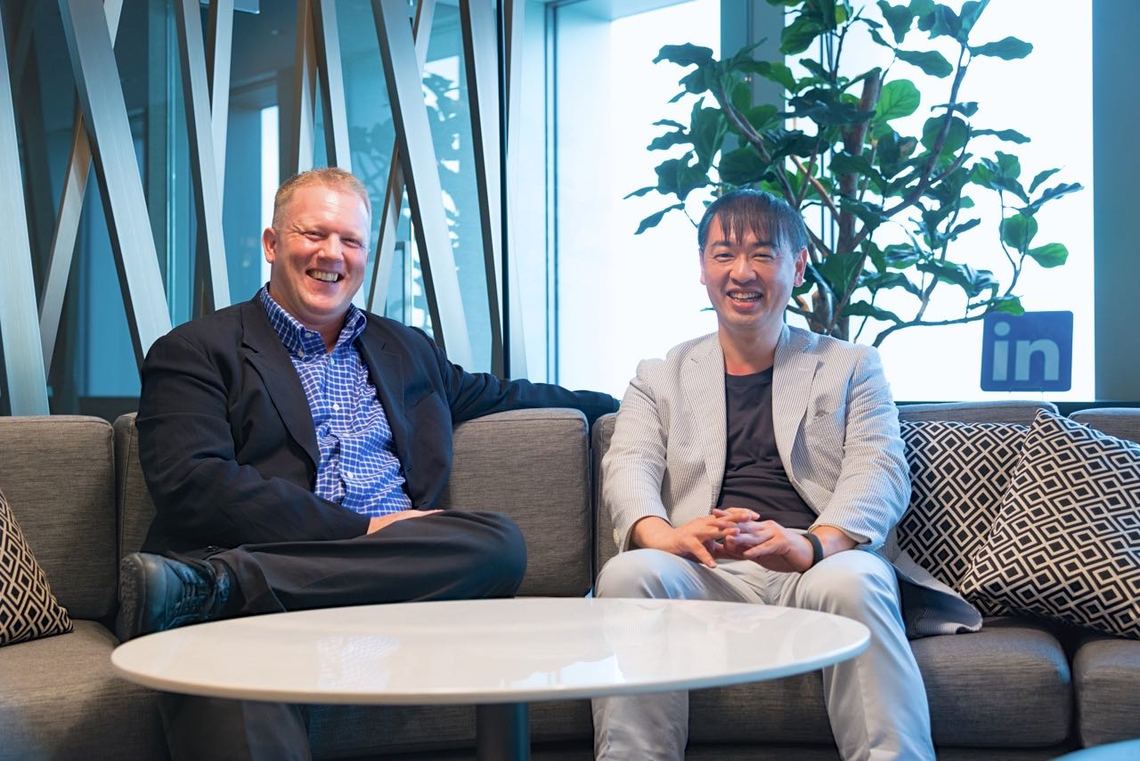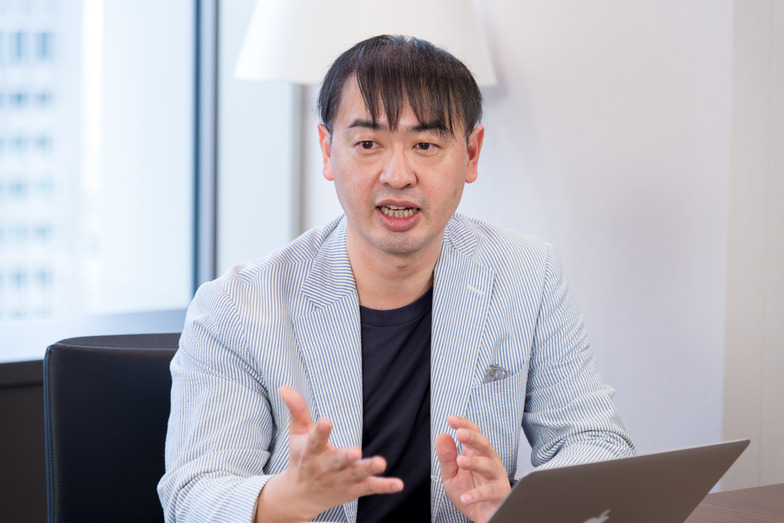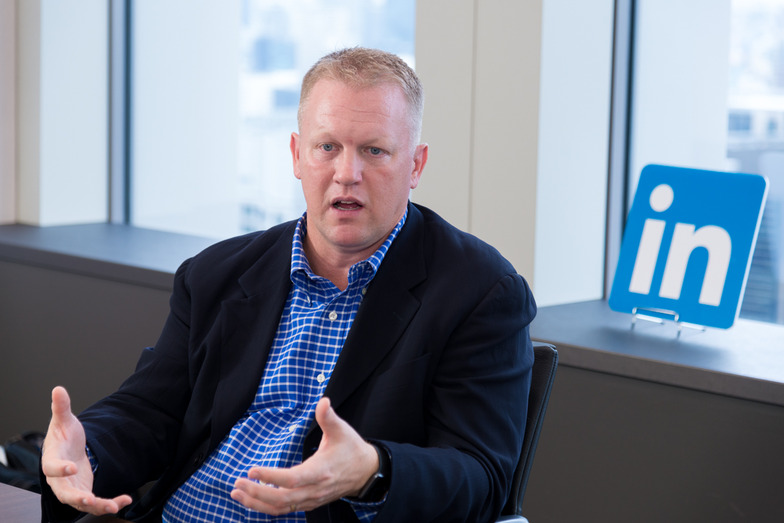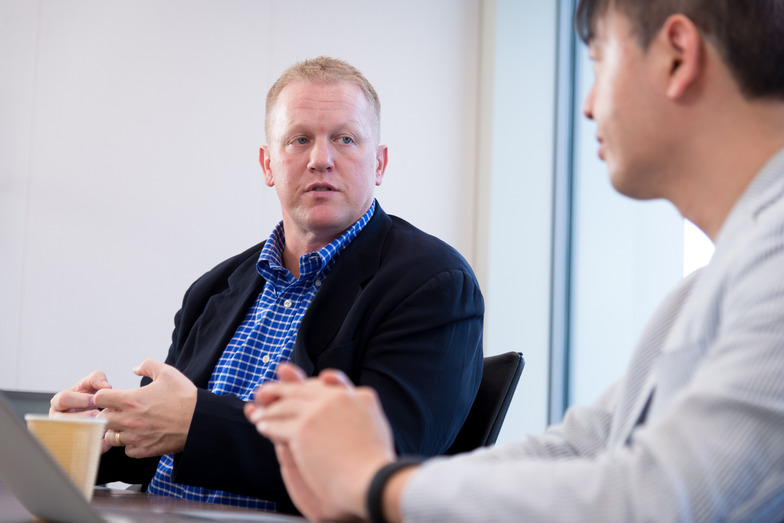LinkedIn, a social networking service (SNS) focused on business use, boasts over 380 million users worldwide. In recent years, it has rapidly expanded its B2B marketing solutions business. This time, Keisuke Konishi of Dentsu Inc. interviewed Brian Burdick, who oversees the global B2B division of LinkedIn's advertising business, about the challenges and outlook for digital marketing in the increasingly globalized B2B business, as well as LinkedIn's future strategy.

From left: Brian Burdick (LinkedIn), Keisuke Konishi (Dentsu Inc.)
LinkedIn's vision: "Creating economic opportunity for professionals"
Konishi: LinkedIn is known as the world's largest professional social networking site for building business connections. However, perhaps because it hasn't penetrated Japan as deeply yet, its value in global B2B business doesn't seem fully recognized here. Could you first tell us about LinkedIn's key features?
Brian: Launched in 2003, LinkedIn now has 380 million users worldwide and is used in over 200 countries. While it's often perceived as a Western-centric service due to its US origins, APAC (Asia-Pacific) is our fastest-growing and most important region, where we are also investing heavily. This reflects the fact that our B2B client companies are focusing on Asia. For example, India now has over 31 million users, making it the second-largest market globally after the US, and China has surpassed 10 million users (see chart below).
Meanwhile, Japan's user base is still just over 1 million. To reach more people, we will continue to focus on improving service understanding.
Konishi: In Japan, platforms like Facebook and LINE tend to be used for both work and personal relationships. The purpose of using a "business-focused social network" doesn't seem very clear. Why do people use LinkedIn?
Brian: Explaining our mission and vision might be the best way to answer that. LinkedIn's mission is "to connect and empower the world's professionals to achieve more." Beyond that, our vision is "to create economic opportunity for all professionals worldwide." We aim not just to build networks, but to create new value through them.
Konishi: I see. LinkedIn recently acquired SlideShare, a presentation-sharing SNS service, and Lynda.com, one of the world's largest online video learning sites. So, these acquisitions align with that vision and mission-based strategy.
By the way, what are the characteristics of LinkedIn's professional users beyond their region? Do they have specific industries or demographics? Also, are there any target groups you strategically prioritize?
Brian: LinkedIn hosts professionals across a wide range of industries, from business and creative fields to the public sector. A key characteristic is the high proportion of users with strong career profiles, including executives, specialists, and influencers. We particularly focus on three segments: senior leadership (executive-level), the "IT Committee" – those with influence over IT and IT purchasing – and Millennials (born 1980-2000), who exhibit distinctive consumption patterns. Millennials on LinkedIn tend to be economically affluent.
B2B Marketing Challenges and Solution Approaches
Konishi: LinkedIn is often perceived as a job-hunting or career advancement platform. However, in recent years, its marketing solutions business, including B2B advertising, has expanded rapidly. What led to this initiative?
Brian: Yes. It's true that our corporate recruitment system, called "Talent Solutions," still accounts for half of our revenue. Since it's for business use, users post their career history and skills, which initially led it to be perceived primarily as a social network for job hunting. That might still be the case in Japan.
The "Marketing Solutions" area, which provides B2B advertising and other services, accelerated after LinkedIn acquired Bizo in 2014. Bizo was the company I founded that provided B2B marketing solutions. By incorporating "Lead Accelerator"—which supports reaching target customers through ads, developing prospects who respond, and one-to-one lead nurturing—LinkedIn has expanded its integrated solutions. Native advertising, particularly "Sponsored Updates" (content-based ads optimized for targets and displayed directly in feeds), has shown significant growth.
In Japan, starting in 2015, we announced a comprehensive funnel marketing solution encompassing everything from ad delivery to Lead Accelerator, strengthening our B2B marketing support initiatives.
Konishi: Japan also has many B2B companies operating globally with significant worldwide market share. However, they often face distinct challenges in branding and marketing compared to B2C, and in many cases, their efforts are still lagging. Brian, where do you see the main difficulties in B2B marketing?
Brian: That's right. Having worked as a B2B marketer before founding Bizo, I understand the on-the-ground challenges well. First, the purchasing process in B2B is extremely long. Then, because there are multiple decision-makers, targeting becomes complex and a major challenge. In other words, you need to deliver information optimized for each target based on which stage of this "long and complex process" they are in. It's fundamentally different from continuously showing a banner to a consumer saying, "You like these shoes? They're about to sell out!"
Konishi: Indeed, in B2B communication, there's a tendency to shut out any information or messages deemed irrelevant to oneself, even more so than in B2C, to gather information efficiently. Providing useful, optimal information is critically important.
Brian: Another major issue in B2B is the significantly higher rate of missed opportunities compared to B2C. Our research shows that 95% of potential customers who initially engage—like visiting a site—leave without registering. Even among those who do register, only about 20% open emails, meaning just 1% remain at this stage. Considering the time and money invested, the likelihood of them sharing their company's information and challenges, and ultimately closing a deal, is very low. Marketers striving to understand and effectively nurture the customer journey in B2B purchasing face considerable challenges.
Five Latest Trends in B2B Marketing
Konishi: Against this backdrop, I believe recent advances in digital marketing have significantly expanded new opportunities and potential approaches within B2B marketing. How do you perceive the current trends of change?
Brian: Let me explain these trends from five perspectives. They represent opportunities that could solve these B2B marketing challenges and also act as tailwinds for our company. Keywords include:
① Emphasis on Relevance in Mobile (
)
② Data-Driven Innovation in Content and User Experience
③ Technological evolution in nurturing
④ Increasing accuracy in predicting success
⑤ Convergence of ad tech and marketing tech
As Mr. Konishi just pointed out, prioritizing relevance is also
As Mr. Konishi just pointed out, prioritizing relevance is also a core principle that runs through our entire B2B support. Nurturing within detailed, complex processes requires message optimization. It demands providing highly relevant content and information to potential customers at specific points in the process.
Mobile devices, especially smartphones, carry a stronger personal element compared to PCs. Seeing irrelevant information here feels even more intrusive. As mobile becomes deeply integrated into both work and daily life, the relevance between users and information becomes increasingly vital.
Konishi: So LinkedIn's strength—customizing and delivering content tailored to each individual's target attributes, interests, and stage in the buying process—is becoming easier to leverage in the B2B mobile shift, compared to ads where you don't know who you're messaging.
Brian: I agree. To briefly explain the other keywords, the next trend is that using data enables us to deliver more relevant content and provide a better user experience.
The third trend is that technological innovation is expanding opportunities for nurturing. While the conversion stage at the end of the buying process is important, focusing more on the nurturing process before that enables even more advanced marketing.
Konishi: In the early stages of engagement with prospects, customer information is often sparse, making it generally difficult to deliver precise messages to each individual target. This is the area that's evolving through the use of social data and technology, right?
Brian: Exactly. LinkedIn has the advantage of leveraging user interest data. For example, we detect signals—what we call "digital body language"—from the voices (posts), information exposure, and reaction behaviors of users with whom we have only a shallow connection. We then utilize these signals for nurturing.
The fourth prediction, which ties into other trends, is the ability to make highly accurate forecasts for branding and marketing activities based on customer data. Finally, the "convergence of ad tech and marketing tech" aims to balance scale and customization. LinkedIn's full-funnel marketing approach to its audience enables marketing that combines the advantages of both.
Konishi: So, by pursuing both the reach scale of ad delivery through user networks and the customization based on ongoing relationships with each individual customer, you ultimately achieve significant conversions.
Brian: Yes. We start by delivering ads to the right users, widening the funnel at the top, and then through nurturing, we also increase the final conversion rate. That's the strength of our B2B support services.
(Continued in Part 2 )
< In Part 2, we explore how LinkedIn's future strategy can solve B2B marketing challenges.>










